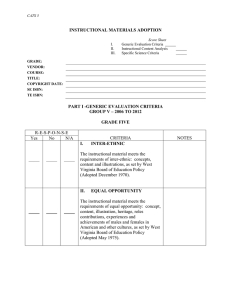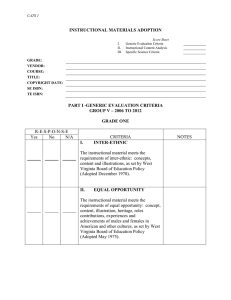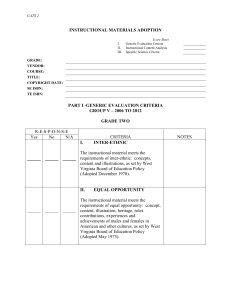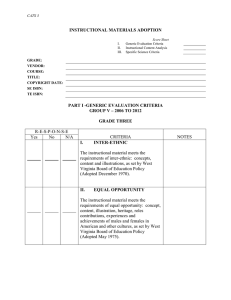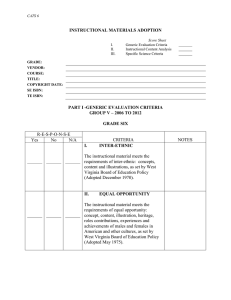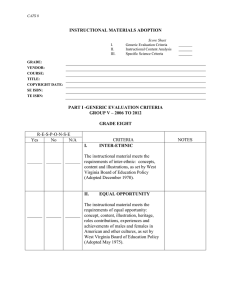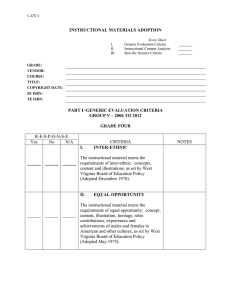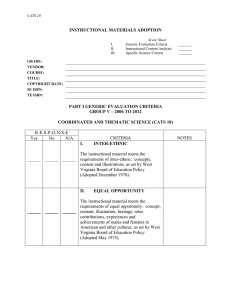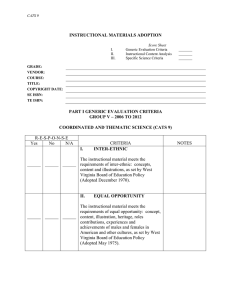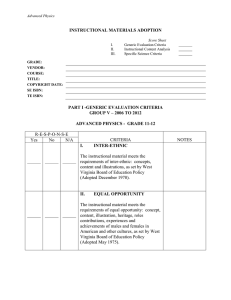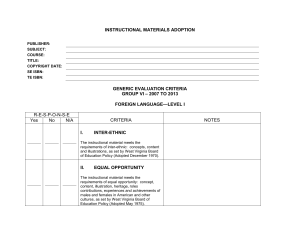INSTRUCTIONAL MATERIALS ADOPTION PART I -GENERIC EVALUATION CRITERIA
advertisement
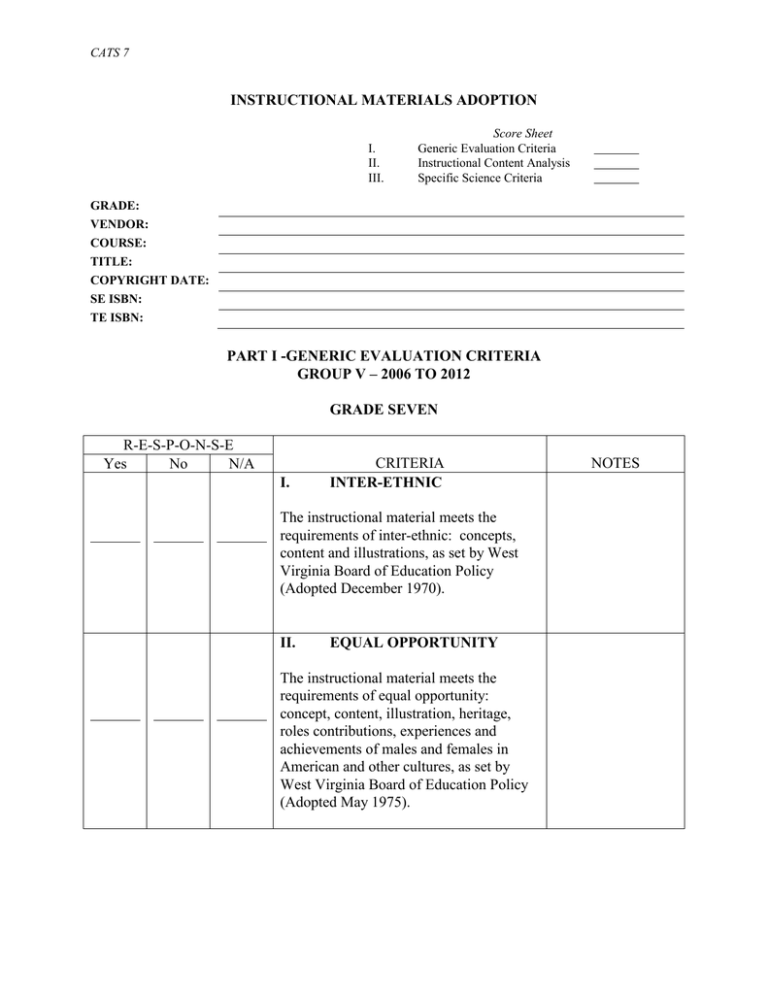
CATS 7 INSTRUCTIONAL MATERIALS ADOPTION I. II. III. Score Sheet Generic Evaluation Criteria Instructional Content Analysis Specific Science Criteria GRADE: VENDOR: COURSE: TITLE: COPYRIGHT DATE: SE ISBN: TE ISBN: PART I -GENERIC EVALUATION CRITERIA GROUP V – 2006 TO 2012 GRADE SEVEN R-E-S-P-O-N-S-E Yes No N/A I. CRITERIA INTER-ETHNIC The instructional material meets the requirements of inter-ethnic: concepts, content and illustrations, as set by West Virginia Board of Education Policy (Adopted December 1970). II. EQUAL OPPORTUNITY The instructional material meets the requirements of equal opportunity: concept, content, illustration, heritage, roles contributions, experiences and achievements of males and females in American and other cultures, as set by West Virginia Board of Education Policy (Adopted May 1975). NOTES CATS 7 Part II – Instructional Content Analysis GRADE SEVEN (Vendor/Publisher) SPECIFIC LOCATION OF CONTENT WITHIN PRODUCT (IMR Committee) Responses I=In-depth 80% A=Adequate 80% M=Minimal 60% N=Nonexistent Less than 60% I A M N The instructional materials program presents information and opportunities in a manner that enables the student an understanding of: 1. 2. History and the Nature of Science a. demonstrate an understanding that scientists formulate and test their explanations of nature using observation and experiments b. demonstrate an understanding of careers and contributions of men and women of diverse cultures to the development of science Science as Inquiry a. the instructional materials program presents information and opportunities that support a minimum of 50% active inquiry, investigations and hands-on activities b. cooperate and collaborate to ask questions, find answers, solve problem, conduct investigations to further an appreciation for scientific discovery c. formulate conclusions through close observations, logical reasoning, objectivity, perseverance and integrity in data collection d. apply skepticism, careful methods, logical reasoning and creativity in investigating the observable universe; e. use a variety of materials and scientific instruments to conduct explorations, investigations and experiments of the natural world CATS 7 (Vendor/Publisher) SPECIFIC LOCATION OF CONTENT WITHIN PRODUCT (IMR Committee) Responses I=In-depth 80% 3. 4. 5. A=Adequate 80% M=Minimal 60% N=Nonexistent Less than 60% f. demonstrate safe techniques for handling, manipulating and caring for science materials, equipment, natural specimens and living organisms g. utilize experimentation to demonstrate scientific processes and thinking skills h. construct and use charts, graphs and tables to organize, display, interpret, analyze and explain data Unifying Themes a. compare and contrast the relationship between the parts of a system to the whole system b. construct a variety of useful models of an object, event or process c. compare and contrast changes that occur in an object or a system to its original state d. identify the influence that a variation in scale will have on the way an object or system works Scientific Design and Application a. research everyday applications and interactions of science and technology b. implement engineering solutions for given tasks and measure their effectiveness Science in Personal and Social Perspectives a. explore the connections between science, technology, society and career opportunities b. analyze the positive and negative effects of technology on society and the influence of societal pressures on the direction of technological advances I A M N CATS 7 PART III - SPECIFIC CRITERIA GRADE SEVEN The Coordinated and Thematic Science Grade Seven (CATS 7) objectives evaluate, interpret, and predict conditions and phenomena of the living and designed worlds. Through a spiraling, inquiry-based program of study, all students will demonstrate scientific literacy in the fields of biology, chemistry, physics and earth/space sciences. The subject matter is delivered through a coordinated, integrated approach with an emphasis on the development of the major science themes of systems, changes and models. Students will engage in active inquires, investigations and hands-on activities for a minimum of 50% of the instructional time to develop conceptual understanding and research/laboratory skills. Safety instruction is integrated in all activities. (Vendor/Publisher) SPECIFIC LOCATION OF CONTENT WITHIN PRODUCT (IMR Committee) Responses I=In-depth 80% 1. 2. A=Adequate 80% M=Minimal 60% N=Nonexistent Less than 60% Science Themes/Subject Matter a. the instructional materials program presents information and opportunities in a manner that enables the student to demonstrate an understanding of the interconnections of biological, earth and space, and physical science concepts (SC.7.4.1) Structure and Function in Living Systems a. develop an understanding of the interrelationships among biology, chemistry, physics, and the earth/space sciences (SC.7.4.1) b. identify and describe disease-causing organisms and the diseases they cause (e.g., bacteria, viruses, protozoa, fungi) (SC.7.4.2) c. explain how human body systems work together (e.g., skeletal, muscular and integumentary systems) (SC.7.4.3) d. compare the variations in cells, tissues and organs of the skeletal system of different organisms (SC.7.4.4) I A M N CATS 7 (Vendor/Publisher) SPECIFIC LOCATION OF CONTENT WITHIN PRODUCT (IMR Committee) Responses I=In-depth 80% 3. 4. A=Adequate 80% M=Minimal 60% N=Nonexistent Less than 60% e. compare the variations in cells, tissues and organs of the muscular system of different organisms (SC.7.4.4) f. construct simple keys to differentiate among living things of similar characteristics (SC.7.4.5) g. use pictures to show cyclical processes in nature (e.g. the water cycle, the nitrogen cycle and the carbon dioxide cycle) (SC.7.4.6) Life Cycles of Organisms; Reproduction and Heredity a. evaluate how the different adaptations and life cycles of plants and animals help them to survive in different niches and environments (e.g., inherited and acquired adaptations) (SC.7.4.7) b. analyze how changes in the environment lead to variations in reproductive adaptations (e.g., seed dispersal, egg laying, live birth) (SC.7.4.8) c. relate how an organism’s behavior response is a combination of heredity and environment (SC.7.4.9) d. analyze the differences in the growth, development and reproduction of plants (e.g., flowering and nonflowering plants) (SC.7.4.10) Populations and Ecosystems a. predict the trends of interdependent populations if one of the limiting factors is changed (SC.7.4.11) b. evaluate the consequences of the introduction of chemicals into the ecosystem (e.g., environmental consequences, human health risks, mutations) (SC.7.4.12) I A M N CATS 7 (Vendor/Publisher) SPECIFIC LOCATION OF CONTENT WITHIN PRODUCT (IMR Committee) Responses I=In-depth 80% 5. 6. 7. A=Adequate 80% M=Minimal 60% N=Nonexistent Less than 60% Structure and Properties of Matter a. differentiate among elements, compounds and mixtures (SC.7.4.13) b. evaluate types of solutions (e.g., solutes and solvents, relative concentrations, conductivity, pH) (SC.7.4.14) Chemical Reactions a. identify chemical reactions involving acids and bases (SC.7.4.15) b. follow the neutralization process using color indicators (SC.7.4.15) c. identify the salt formed in chemical reactions (SC.7.4.15) d. write word equations to describe chemical reactions (SC.7.4.16) Energy a. describe the behavior of individual particles and verify the conservation of matter while exploring the melting and freezing of pure substances (SC.7.4.17) b. trace the energy flow during phase changes (SC.7.4.18) c. relate characteristics of light and sound to waves (e.g., amplitude, pitch, wavelength, reflection, absorption rate, color) (SC.7.4.19) d. investigate application of lenses to science (e.g., microscopes, telescopes, magnifying glass, periscopes) (SC.7.4.20) e. identify characteristics of AC and DC circuits (e.g., batteries, transformers) (SC.7.4.21) f. explain conservation of matter and energy qualitatively and recognize that energy can be changed from one form to another (SC.7.4.22) I A M N CATS 7 (Vendor/Publisher) SPECIFIC LOCATION OF CONTENT WITHIN PRODUCT (IMR Committee) Responses I=In-depth 80% 8. 9. 10. 11. A=Adequate 80% M=Minimal 60% N=Nonexistent Less than 60% Motions and Forces a. experiment with simple machines to demonstrate the relationship between forces and distance (SC.7.4.23) b. explain the effect of gravity on falling objects (e.g., object dropped on earth and on moon) (SC.7.4.24) c. analyze motion graphically and use vectors to represent direction of motion (SC.7.4.25) Structure of the Earth System a. depict and relate causes of tides, surfs and currents (SC.7.4.26) b. examine the relationships among air masses, oceans, weather, convection currents and the sun’s energy (SC.7.4.27) c. interpret and create topographical maps (SC.7.4.28) Earth’s History a. compare and contrast periods of geologic time using rocks and rock layers (SC.7.4.29) Earth and the Solar System a. explain and model using manipulatives how the Earth’s tilt and revolution determine the seasonal changes and weather patterns (SC.7.4.30) b. recognize the changes involved in the life cycle of a star (SC.7.4.30) c. describe and compare the physical characteristics of celestial objects (SC.7.4.32) d. compare the characteristics of the members of our solar system (SC.7.4.33) I A M N
